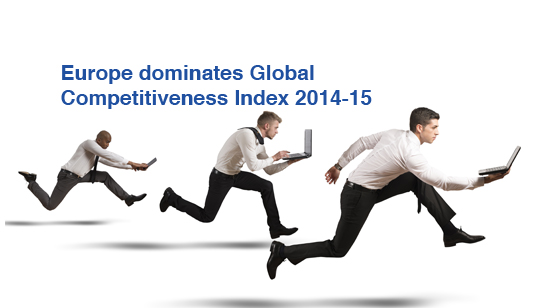Europe dominates Global Competitiveness Index 2014-15
The World Economic Forum issued its “Global Competitiveness Index 2014–15: Country Profile Highlights” (GCI) report in September. The report defines competitiveness as the “set of institutions, policies and factors that determine the level of productivity of a country”. In order to assess competitiveness, the WEF divided the 144 nations it surveyed into one of three classifications, depending on their stage of development and measures competitiveness along 12 broad metrics, called pillars, in order to see which of the drivers actually drive productivity in a country. It also looks at their strengths and weaknesses.
The top ten, which features predominantly European countries, reads as follows:
- 1. Switzerland
- 2. Singapore
- 3. United States of America
- 4. Finland
- 5. Germany
- 6. Japan
- 7. Hong Kong SAR
- 8. Kingdom of the Netherlands
- 9. United Kingdom of Great Britain and Northern Ireland
- 10. Sweden
The Middle East and North Africa region
Unemployment remains the greatest challenge and priority at the economic level for the Middle East and North Africa region in general. While the region continues to be affected by political unrest, which continues to affect competitiveness, some countries such as Jordan and Morocco have shown some positive signs by climbing up the competiveness level ranking.
The highest ranked Middle East/Arab country is United Arab Emirates. It has moved up seven places to occupy 12th position. Qatar, previously 13th, falls to 16th. The Kingdom of Saudi Arabia is continuing a downwards trend falling from 20th to 24th.
Jordan improved by four positions to 64th place, whilst clearly being affected by the global financial, economic and political crisis in neighbouring countries. While Turkey ranked second globally on the ‘Global Entrepreneurial Report’, it merits only 45th position on the GCI.
Morocco’s case as explained by our correspondent in Morocco ‘Villes du Maroc’ – Said Alaoui
Morocco’s competitiveness ranking as awarded by the World Economic Forum (WEF) consolidates its reputation as North African champion in this regard.
According to this latest report on competitiveness, the Kingdom has risen seven places to 72nd. It is said to be in a much better position compared to the previous period (2013-14) in an area affected by a profound geopolitical instability. In the opinion of the WEF experts, this progress is mainly the result of reducing the budget deficit and improving education and innovation capabilities. The report also mentioned improvements in some aspects of institutional order in a climate of social and political stability, as well as efforts in recent years to improve the business climate.
Thus, the process of economic diversification is important for the future growth of the country, to the extent that it stimulates exports and foreign direct investment (FDI) in industries with high added value. The report cites some of the features of Morocco’s competitiveness including the level of safety, efficiency, processes for business creation and a strong banking sector.
Nevertheless, Morocco may do better by committing itself to providing quality education, reforming its labour market, particularly in order to increase the share of women in the workforce. This will in turn enhance the country’s human capital, increase the use of Information Technology and Communication (ICT) in enterprises, and further strengthen the country’s competitiveness.
The world’s least competitive economies
The bottom ten countries in the GCI rankings provides interesting reading. Six are in sub-Saharan Africa, one is in the Caribbean, Yemen alone comes from the MENA region, with the list completed by Timor-Leste from the ’emerging and developing Asia’ region.
Many of these nations lack economic essentials such as infrastructure, education and access to financing, making them the least competitive in the world.
- 135. Burkina Faso
- 136. Timor-Leste
- 137. Haiti
- 138. Sierra Leone
- 139. Burundi
- 140. Angola
- 141. Mauritania
- 142. Yemen
- 143. Chad
- 144. Guinea
These countries often fail to develop quality infrastructure such as roads, telecommunication systems or transportation networks. Maintaining strong nationwide institutions and infrastructure often requires a great deal of investment. The least competitive nations typically lack the ability to borrow large sums of money in order to finance investment. With only a few exceptions, these countries have relatively low debt levels; in these poorer nations, access to financing is often a challenge not just for businesses, but also for governments.
Still, the least competitive nations face larger impediments than debt. When discussing fundamental prerequisites for any nation, one of the report authors noted that “any nation requires fairly strong leadership”, and leadership issues can “prevent progress for countries’ competitiveness due to countries not making investment or functioning well”. Most have experienced a major regime change in the past two decades.
How was the report created?
To identify the most and least competitive economies in the world, Middle East Business reviewed the WEF’s Global Competitiveness Report for 2014-15. The WEF has generated a Global Competitiveness Index (GCI) since 2005, which includes weighted average measurements for 114 components making up 12 pillars. Weights for various pillars depend on the country’s stage of development. All GDP figures, as well as figures on government debt as % of GDP, were provided to the WEF by the International Monetary Fund.



























